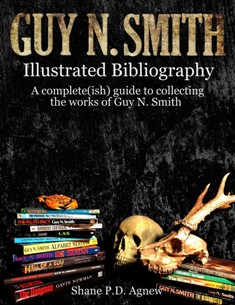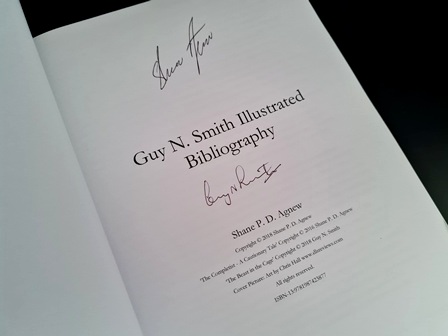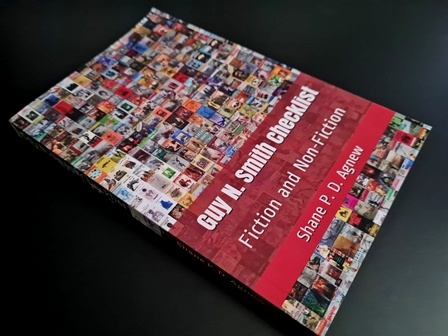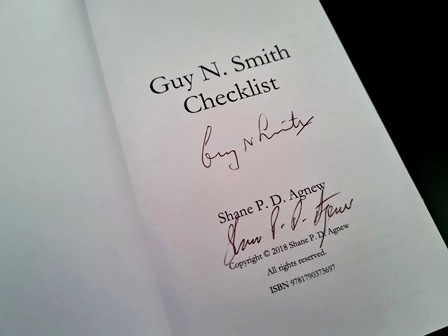
First published in September of 2018, Shane P.D. Agnew’s oversized bibliography ‘Guy N Smith: Illustrated Bibliography’ offered up a complete(ish) guide to collecting the works of prolific author Guy N Smith.
When you first get your hands on a copy of this book I guarantee you’ll be blown away by the size of the weighty tome. It really is a hefty slab of a book. Measuring approximately 8.5” (W) x 11” (H) x 1” (D) this is a big coffee table sized reference book that’ll need a good-sized shelf to support it.
I’ve known Shane (the book’s author) for a number of years now, meeting up with him each September at the annual Guy N Smith fan convention. Aside from his dry sense of humour and Northern charm, one of the first things you notice about Shane is his fierce passion for Guy N Smith’s work and near-obsession with collecting absolutely every publication from the prolific author. Did I say ‘near-obsession’? Apologies, that should read ‘monstrously unhealthy obsession’.
You see, Shane’s a diehard fan and determined collector. Each year at the fan convention he nabs all kinds of weird and wonderful titles in the auctions. Then at home he scours the internet for all sorts of GNS and related publications that he’s learnt about (usually from conversations with the man himself). From obscure foreign editions, to all the different print editions of each title, to newspaper & magazine articles, to copies of porno mags that included Guy’s smutty scribblings, and all variety of weird and wonderfully varied publications in between.
In his introduction Shane admits he originally embarked on the project as a way of cataloguing his own GNS collection (music to my accountant ears). Then the project expanded as he sought out the various titles and editions he found was missing. The wheels were now well and truly in motion for the foundations of putting together a ridiculously comprehensive bibliography.
Before I breakdown the various aspects of the bibliography, I thought I’d give an overview of the book as a whole and its intended use, from one GNS fan to another.
After you first start picking up and looking out for more of Guy’s novels, it’s usually not long before you realise there’s an absolute shit load of them out there. Guy was (and still is) one of the most prolific pulp horror authors – if not the most prolific. He’s got over one-hundred novels under his belt, not to mention short stories, non-fiction books, articles, chapbooks, soft and hardcore pornographic stories etc.
Of course your GNS collection usually starts because you’re trying to get your hands on of all his pulp horror titles. But as your collection expands, and you hunt down the ‘Truckers’ books, along with ‘The Pony Riders’ (1997) and the like, so the addiction kicks in. It’s not a particularly big jump from there to searching out the numerous anthologies with Guy’s work in them, and then on to the magazines and periodicals. Collecting all the editions of the same title is possibly a step too far for me. Although I have to confess to having a few different editions of particular titles (mostly because of the differing artwork) as well as a handful of foreign editions (Shane’s enthusiasm is contagious). Nevertheless, whatever your level of collecting of Guy’s work, this bibliography makes the task that much easier.
Indeed, Shane’s both taken the pain out of working out which titles or editions are out there, and he’s also opened up a whole new level of collecting Guy’s work. I bet you didn’t know about half the titles catalogued in this book. Quite frankly it’s incredible. Guy N Smith’s a damn prolific writer, but I guarantee you didn’t realise just how prolific he’s been. Across fiction and non-fiction, there’s just so much that the man’s had published. The question for you is, which publications are you trying to collect? How far do you want to go with your collection? Where do you stop?
With this magnificently comprehensive cataloguing of (nearly) all the titles that include Guy’s work, you’re able to look at your current collection and see exactly what you’re missing. You can choose to take your collecting to another level, or just fill in certain gaps within your current collection.
The bibliography covers Guy’s career in writing, from the comics he drew as a child for pocket money (which had only a very limited number printed), to the forthcoming releases of ‘Sabat 5: Wistmans Wood’ (2018), ‘The Reaper’ (2018), ‘Postcards From The Void’ (2018), and ‘Great British Horror 3’ (2018).
From start to finish the bibliography provides full colour pictures of each and every publication. For around 95% of these, this will be of the cover artwork. There are a few of the more obscure newspaper articles where the cover has been lost, and so instead a photo of the article itself is included. There’s also a very small number of listings where Shane knows of the existence of a particular publication (say from Guy’s personal records of what he had published) but he’s been unable to track down a copy as of yet. Here you just have a ‘No image available’ box in its place. Although I’m sure after a couple more years, and a few editions of the bibliography later, some of these images will start to appear, as Shane continues with his endless task of collecting.
One of the really handy aspects of the book is the inclusion of the ISBNs for each edition. So, say you want to collect all the first editions of the GNS pulp horrors. No problem at all now. Even if a website or internet auction listing doesn’t state ‘First edition’, now you can quickly and easily search for, or confirm an edition, using the ISBN in the Bibliography.
Each listing in the bibliography also includes a ‘Contents’ section. Now, this really comes into its own for anthologies, omnibuses and periodicals etc. If you’re not actually that interested in collecting all the different GNS publications, but nevertheless still want to get your hands on and read all his stories, then this enables you to see what publications you’ll need to seek out in order to get your hold of the stories. You see, some short stories have been collected and reprinted in easy to obtain omnibuses. Whereas others have only been printed the once or twice, in which case you’ll have to track down the original publication if you want to get your hands on that particular tale.
Of course, if you use this Bibliography, after a while your collection is likely to have grown considerably. Keeping track of what you have and what you still need to get, starts to get a tad tricky, especially if you’re trying to collect multiple editions of the same title (‘Night Of The Crabs’ (1976) has some eleven editions, not including foreign editions, at the time of writing). To assist with this, Agnew’s included a ‘Collected’ tick box on all the listings, so once you’ve got your hands on a particular publication, you can tick it off in the book.
The sheer effort and dedication that’s gone into creating this unbelievably comprehensive bibliography is breath-taking. Just from flicking through its many pages you begin to realise what a mammoth task it must have been to pull together all of this information. Years upon years worth of collecting. Of Shane rooting through Guy’s own collection and poring over his handwritten notes and journals to hunt down any incredibly obscure titles that would otherwise have been lost and forgotten.
The sheer breadth of publications catalogued in this book is astonishing. You have everything in here from the Russian unauthorised hardback of ‘Accursed’ (in a limited edition slipcase no less), to the issue of ‘Screw’ magazine that included one of Guy’s smuttier writings, to the issue of ‘Home & Freezer Digest’ with Guy’s article about living off your land, all the way to the ‘Pensioner Today’ booklet that was produced for ex-employees of HSBC and included an article by Guy on his shed! You’ve also got listings for all the chapbooks (including all the fan convention only ones), all the issues of ‘Graveyard Rendezvous’ and ‘Caerlaverock’, and all the ‘Gamekeeper and Countryside’ issues with articles by Guy in them (to mention but a few). There’re lists of the magazines with articles about Guy in them, obscure fanzines, and of course, a complete list of all the London Mystery (Selection) periodicals that include Guy’s short stories in them.
I guess one thing to note is that Shane’s only catalogued physical publications in his bibliography. There’s no mention of ebook editions or audio books. Furthermore, any items considered as paraphernalia (such as keyrings, bookmarks, promotional posters and sample dust jackets etc) have also not been included. This is a bibliography of physical published written work. Ink on paper.
Finally, the book includes a section of ‘Unverified’ publications and editions which covers publications that (at the time of printing) Shane’s not been able to verify of their actual existence. Similarly, Shane’s also included a handful of empty listings at the back of the book for you to include any obscure publications you unearth that have been missed (although in his introduction Shane urges you to get in touch with him if you do know of any such listings).
There’s other stuff in the book (such as a previously unpublished short story by Guy), but in a nutshell what I’ve covered above provides you with the essence of this magnificently comprehensive bibliography.
Although, as this is DLS Reviews, I will of course get my scalpels out and dissect the book further, section-by-section. So for those who want to know more, keep reading…
Introduction – Shane P.D. Agnew – 1 Page
The book begins with a one page introduction by the book’s author. Here Shane details what he set out to achieve in his book, his motivations for embarking upon the project, the problems faced and an honest admittance that the book is no doubt still incomplete. It’s a frank and candid opening statement that allows you to understand the scope (and ever-so-slight limitations) of the bibliography.
The Completist – A Cautionary Tale – 2 Pages
It was on the eve of the 2015 Guy N Smith annual fan convention that lifetime (obsessive) collector Shane Agnew hypothesised about the existence of ten levels of GNS collecting. Since that day Shane has given the notion of these ten levels a great deal of thought, and now offers up his cautionary tale – detailing the specifics within each of these ten levels…
This is absolutely hilarious. From one fan to another – there is just so much to relate to in this escalating list of Guy N Smith collecting. We’ve all been there at Level One - picking up your very first shabby Guy N Smith paperbacks from a musty smelling charity shop. From here it’s babysteps through the various levels, all of which (if you’re an avid GNS collector) you’ll recognise. It’s honest and so utterly true – and it’s so much more amusing for it. Indeed, laced with humour from the outset the ten levels are crammed full with so much dry wit that you’ll find reading them just as rewarding (and amusing) the second and third time around. In fact, I’ve just reread Shane’s entire offering (again for like the fifth time or something) and still can’t wipe that silly grin off my face. Every word he writes is so very very true.
The ‘story’ was originally published within the exclusive ‘Hell Of A Guy’ (2016) anthology which celebrated twenty-five years of the Guy N Smith Fan Convention.
Foreword – Guy N Smith – 2 Pages
The man himself, Guy N Smith, jumps in next with a short foreword in which he provides a brief overview of his incredibly varied writing career, from his early writing of stories for boy’s story papers as a young lad, all the way up to the 1990’s with the creation of Blackhill Books and the annual fan convention. For those who haven’t already read ‘Pipe Dreams’ (2013) or aren’t otherwise familiar with Guy’s prolific and varied writing career, then this short foreword provides a good overview. Furthermore what it also does, is set the scene perfectly for the rich and varied catalogue of books and assorted publications in the following pages of this incredibly in-depth illustrated bibliography of the great scribbler’s work.
Contents – 70 Pages
Now it might seem a tad strange to be writing about the contents pages of a book, but in this circumstance it’s kind of necessary. You see, the contents pages themselves form a good portion of the bibliography. Indeed, at seventy odd pages, they take up a healthy chunk of the book. That’s because for a book of this nature, these pages are fundamental to its success. At the end of the day it’s a reference guide. A book that you use to look through and locate particular titles, hopefully with relative ease. In order to achieve this, particularly when you have just shy of a thousand listings detailed in the book, is to engineer an easy-to-navigate contents section. And that’s exactly what compiler Shane Agnew’s done.
As stated at the top of the first contents page:
“The book is divided into two main sections, Fiction and Non-Fiction, and subsequently further subdivided into different categories. For ease of navigation the sections and categories are colour coded. The publication titles are in alphabetical order within each category and the checklists also follow the same colour codes”.
Furthermore the book has two differently ordered checklists. The first checklist (33 pages in length) is first split between the publication type (fiction or non-fiction) and then ordered by the ‘Story Name’ (i.e. the name of the particular story or article). So for an example, if say, you want to know what publications the short story ‘The Brain Crawlers’ appeared in, then you can use this section to look the story up that way.
The second checklist (35 pages in length) is first split into the section Type/Category (i.e. ‘Novel/Book’, ‘Children’s’, ‘Omnibus’, ‘Anthology’ etc) and then ordered by the ‘Story Name’. This second checklist allows you to first home into the type of publication you’re interested in, say if you only wanted to look within ‘chapbooks’ for a particular story or publication, and then drill down into the different titles.
The colour-coded sections covered in the bibliography are: Novels, Children’s Novels, Omnibuses, Chapbooks, Graphical, Anthologies, Graveyard Rendezvous, GNS Zines, Booklets, Magazines, Periodicals, Newspapers, Unverified, and Interviews/Articles/Miscellaneous.
The sections are further sub-divided into smaller ‘genre specific’ subsections for further ease of navigation. For example, the ‘Novel/Book’ section (within ‘Fiction’) is further subdivided into ‘Horror’, ‘Thrillers’, ‘War’ and ‘Western’.
The book is also split between Fiction and Non-Fiction, so in essence many of the above sections will have two slots in the book, one for fiction and then the other for non-fiction.
The Listings – 252 Pages
Each page includes up to four publications (other than the ‘Interviews/Articles/Misc’ section which includes up to nine listings per page). The publication listings are all displayed in the same format. You have a full colour picture of the publication, the publication title, the specific edition, the publication date, the country of publication, the publisher, the cover artwork artist/photographer, any relevant notes on the publication (such as the ISBN, the editor, how many copies were published if part of a limited edition run etc), a contents section (detailing the GNS stories included in the publication) and finally a ‘collected’ box for you to tick once you’ve managed to get your hands on the publication.
The Beast In The Cage – Guy N Smith – 4 Pages
For the past five years Lester Foulkes had been the resident gamekeeper at the small Black Hill Estate in the Shropshire/Welsh border hills. Approaching his seventieth birthday, although the work involved was relatively easy, Lester was beginning to find himself getting increasingly tired. Tired and forgetful. Which is why it came as no real surprise to Lester as he got himself ready for bed, that he suddenly remembered he’d not checked the fox trap that day. Despite it being the middle of the night, he knew he’d have to go out and check it. It was the law. And with the size of the cages they used on the Black Hill Estate, anything could get trapped within it. There was only one way to know for sure, and that was to go out there and take a look for himself…
It seems reasonably fitting that for the bonus short story within a book documenting his extensive career in writing, Guy would return to writing about werewolves lurking on the Shropshire/Welsh border hills - the subject of his very first ever novel ‘Werewolf By Moonlight’ (1974). Here we have a short tale that spends the majority of the time edging towards the unveiling of ‘the beast’, with a textbook Guy N Smith style of build-up that gets you eagerly anticipating the inevitable horror that awaits us. Smith does what he does best, getting us right on the edge of our seats up to the point that the beast is out and ready to take its next victim. However, it’s at this point that Smith decides to suddenly cut the tale short, ending the story in a frustratingly clinical way. You can’t help but feel like there should have been more to the story. It’s an ending that feels a tad like it’s just taken the easy way out. Nevertheless, for those that enjoy a good Guy N Smith yarn – there’s plenty of the man in this story. An ending cut frustratingly short but altogether not a bad read.
The bibliography runs for a total of 341 pages.

© DLS Reviews














